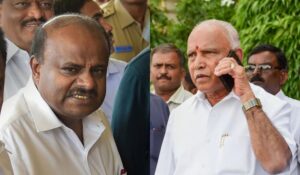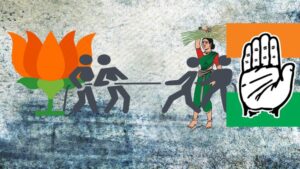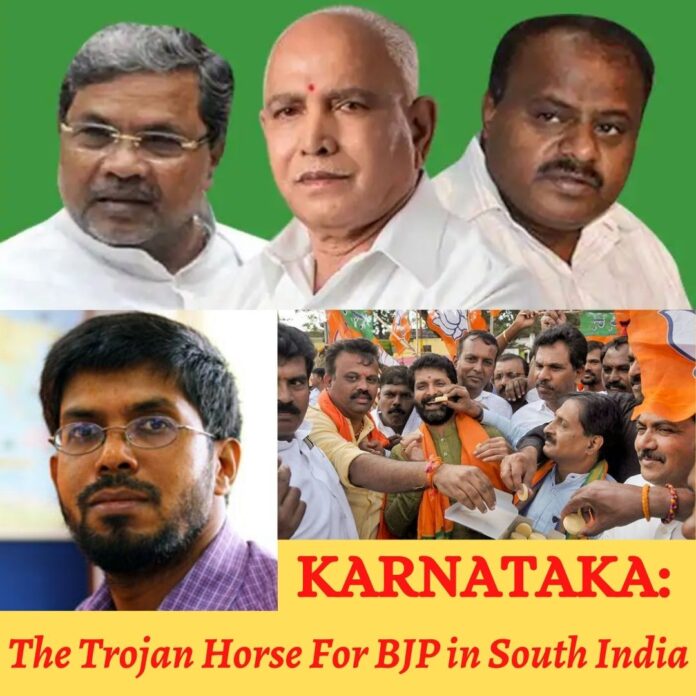To some extent, BJP has grown naturally in Karnataka. So far this natural growth has been just too slow. Now it appears that it has upped its pace.
BJP has grown due to the fact that other parties have died down. As Janata Dal slowly lost itself, the bigwigs of that party migrated to BJP, naturally, BJP expanded. This is another face of BJP.
BJP has grown by the phenomena of buying MLAs and putting them in its basket. Hence, the door for BJP in the south has not been carved in a single wooden plank. It does not have uniformity from bottom to top. It is a structure that has been built haphazardly.
But how does it matter how you come to power, whether you come from the front door or creep in through back door- power is power! That too at a time when BJP couldn’t find its foothold in the south.
Probably this happens in politics. If a party, however weak it is, if it manages to stay alive for long, if it has the perseverance in the efforts to come to power, then one day, the door of power opens for it. Because people start getting disillusioned with the ruling party or the party which repeatedly comes to power.
Then they look for new parties. At that time the party which is ready gets the opportunity. A similar phenomenon has happened for BJP. And there are indications that in other southern states too, BJP might get such an opportunity in the distant future.
2. History
Earlier when BJP was called Janasangh, it couldn’t play an important role in Karnataka. And it looked like an aberration when BJP won 18 seats in the 1983 elections after its rebirth as BJP in 1980 and it soon ran out of beginner’s luck within two years.
When elections happened in 1985, BJP could win just two seats. And after a whole decade of having MLAs in single digits, the party showed growth in 1994. It bagged 40 seats and became the main opposition party. The frame of the door was ready. But another decade passed by just looking at just the door frame.
In the meanwhile, Ayodhya happened and BJP started ruling in many states in the north yet it couldn’t gain much in the south. Idgah Maidan case in Hubballi, Datta Peetha row in Chikkamagaluru, communal riots in Suratkal of Dakshin Kannada district- all these and other such efforts couldn’t get much success in growing in Karnataka. In the 1999 elections again BJP won just 44 seats.
So, the BJP which was standstill for a decade saw its rebirth on the political tomb of Janata Parivar. In the next five years, Janata Parivar was dismantled totally. The strongmen of Janata Parivar, who lost their base started knocking on the BJP door. How could BJP say No to those bigwigs when it was struggling to retain their deposits despite the spirit they had for elections. BJP gave shelter to all those who came knocking. BJP held their hands and they held BJP’s hands. Hence when they fought elections together in 2004, they won 79 seats. BJP came out as the single largest party. But the target of 113 seats was still too far.

Again, BJP remained as the opposition party for the next two years and came to power quite unexpectedly. HD Kumaraswamy of Janata Dal-Secular, wanted to be chief minister even before he became a leader. The coalition government that came in power in 2004, was pulled down as HD Kumaraswamy made a pact with BJP. And then, a new coalition government came into power. By sharing power with JDS, finally, BJP became a ruling party. After 25 years of existence, patience did come to fruition. BS Yeddiyurappa became Dy CM in Kumaraswamy government.
The way a party grows when not in power and when in power are different. BJP which was growing without being in power till then entered into a new phase of growing being in power. We cannot say what would have happened if that had continued being in power for long. But what happened was totally different. After 20 months, power was to be transferred to BJP, and Yediyurappa was supposed to be CM, but Kumaraswamy didn’t keep his word. Government fell.
But Kumaraswamy’s betrayal became a boon for BJP. It appeared as Kumaraswamy who belongs to the Vokkaliga community refused to transfer the power to Yediyurappa who belongs to the Lingayat community. And hence Yediyurappa came to be the strongest leader of Lingayats.
BJP almost got the entire support of the Lingayat community. Until then Yediyurappa had grown depending on BJP, but from then BJP started growing depending on Yediyurappa. In 2008, BJP got 110 seats. Just three short of a majority. They had somehow managed it and come to power on their own. The door to BJP in the south was thus opened.
The next five years of BJP rule is a case study in itself. It exhibited what happens, what are the repercussions if a party that has a history of unnatural growth comes to power. If one were to study and document all the political distortions that the state saw in those five years, it would be studying for scholarship essays.
In reality, the first BJP government was not a government of one party, it was a coalition government in the form of a one-party government.
There were so many factions- one being a faction of those primarily from BJP. In that faction there was a sub-faction that was completely dedicated to RSS and another sub-faction that wasn’t too fond of RSS. Yet they were primarily from BJP since the beginning. And there was another faction of those who came from Janata Parivar.
By then, to increase their strength in the assembly they had bought several congress and Janata Dal MLAs. Operation Kamala, the infamous operation through which many of these MLA’s were bought had their own faction.

More importantly, there was another interesting faction, that was the faction of Bellari mining barons. This faction was instrumental in secretly finding the operation Kamala, and there are no limits to the games this faction played in and outside the government during that period.
There was no one to control this BJP government which had become a party of factions. At the national level too, they were weak.
In 2009, BJP had lost for the second time consecutively. And that was the end of the long period of Advani and BJP. Hence there was no high command control over the BJP government in the state and outside the state, all the factions were pulling the government in different directions. The totally inexperienced and unstable government was totally unstable was soon labeled as one of the most corrupt governments. Yediyurappa had to resign and go to jail. BJP by the time they completed their tenure had seen three chief ministers and had broken into three. So, no one could say if the door to the south for BJP had opened or there were hundreds of small holes that worked as entry sites. Hence, the first government came to an end.

























[…] Karnataka: The trojan Horse for BJP in South India […]